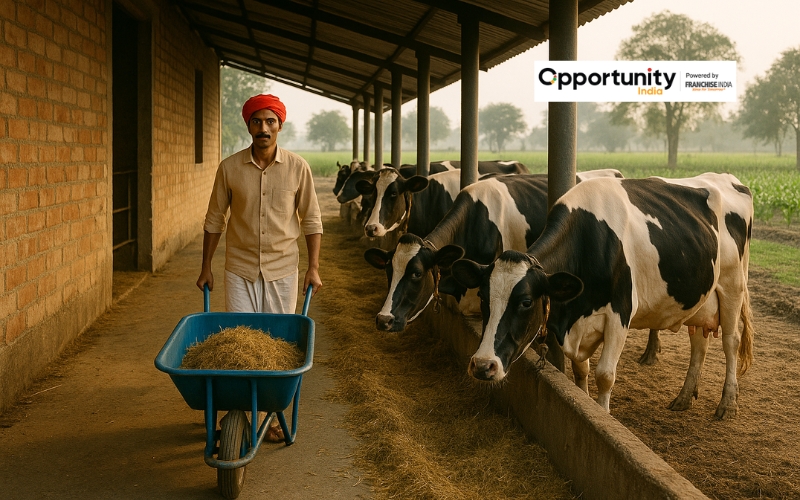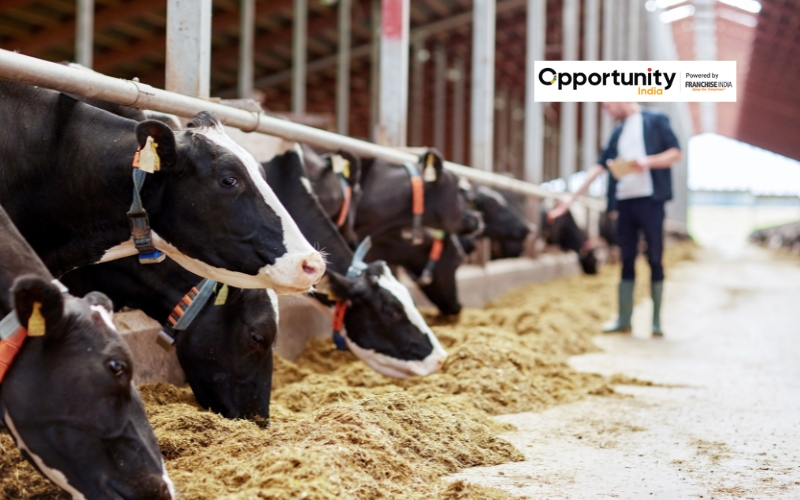
Have you ever wished to manage your own dairy farm? Do you want to sell healthy milk and dairy products from your backyard, milk fresh Desi breeds, and wake up to the sound of cows mooing? You're not alone, though. One of the most profitable and sustainable agribusinesses in India is dairy farming, which is rapidly gaining popularity due to the rising demand for fresh, organic, and locally produced milk. Therefore, if you have a strong interest in farming, raising livestock, and creating a reliable source of income, let us take you step-by-step through the process of starting a dairy farming business in India.
The Indian Dairy Landscape: Opportunities and Trends
The size of the Indian dairy market increased from INR 18975 billion in 2024 to INR 57001.81 billion by 2033, with a compound annual growth rate (CAGR) of 12.35% from 2025 to 2033. The dairy business in India, the largest milk producer in the world, is thriving and constantly expanding. Due to the rising demand for milk and dairy products with added value, modern dairy farming in India offers a substantial opportunity for entrepreneurship. A solid business plan, a thorough awareness of the necessary investments, and a grasp of the fundamentals of operations are important if you're thinking about entering this profitable industry.
Also Read: Rice Mill Business Plan in India
Dairy farming is becoming one of the most lucrative agribusinesses in India due to the rising demand for dairy products, including milk, paneer, curd, ghee, and butter. Starting a dairy farm in India may be a profitable, scalable, and sustainable endeavor for any farmer, regardless of experience level.
Several things contribute to this growth:
- Growing Consumption: The amount of milk and milk products consumed per person is rising as a result of population growth and rising disposable incomes.
- Transition to Value-Added Goods: Processed and value-added dairy goods, such as cheese, yogurt, flavored milk, and butter, are widely available and have better profit margins.
- Technological Developments: Improving cold chain infrastructure, IoT-enabled animal health monitoring, artificial insemination, and other contemporary farming methods are increasing production and decreasing waste.
- Government Support: Several government programs and subsidies, as well as foreign direct investment in dairy processing, are giving the industry a significant boost.
- Cooperative Model: Amul's and other cooperative models' success shows how small-scale farmers can gain from coordinated milk collection and processing as a group.

Crafting Your Dairy Farm Business Plan
Starting a dairy farm business may look like an appealing business to pursue but it surely demands a business strategy and a lot of hard work. Your success blueprint is a strong business plan. It describes your goals, plans, and financial forecasts.
What is your Executive Summary?
Provide a brief overview of your dairy farm's goals, objectives, and USP first. Describe the legal form of your farm (company, partnership, or proprietorship), your long-term objectives, and your dedication to sustainability and excellence.
Market Analysis
Examine the demand for milk and dairy products in the area. Do dairies now exist, and if so, what are their advantages and disadvantages? Find possible clients, such as direct buyers, nearby milk suppliers, confectioneries, lodging facilities, or bigger dairy cooperatives.
Examine your rivals. What are their product offers, pricing policies, and customer support policies? What distinguishes your farm? Choose between diversifying into value-added goods (paneer, ghee, curd, lassi, etc.) or concentrating just on raw milk. Although value-added products need more processing and marketing, they frequently generate larger profits.
Also Read: How to Start a Laundry Business in 2025 – Low Investment, High Returns
Land and Infrastructure
You will need land for:
- Cattle shed (open or covered)
- Fodder cultivation
- Water supply system
- Manure pit
- Milk storage and chilling
Space needed per animal: 80–100 sq. ft.
A 10-cow unit needs approx. 1000–1200 sq. ft.
Housing and Shed Design
- Adequate drainage, cleaning, and ventilation.
- Separate areas for ill and pregnant animals.
- Raised mangers for feeding.
- Water troughs to provide potable water.
Tip: Use inexpensive roofing materials (thatched or asbestos) to lower the initial outlay.
Fodder and Feed Management
70% of all dairy expenses are related to feed.
Plan for fodder:
- Green fodder: maize, berseem, napier grass.
- Dry feed: rice or wheat straw.
- Concentrates: grains, cottonseed cake.
- Salt and mineral mixture.
To cut expenses, you can cultivate green fodder on 1-2 acres of land.
Products and Services
Clearly define what you will offer. This might include:
- Raw milk (various fat percentages)
- Pasteurized and packaged milk
- Ghee, paneer, curd, lassi
- Organic milk (if applicable)
- A2 milk (from indigenous breeds)
Also Read: Start Your Dream Cosmetic Business with This Foolproof Business Plan
Milking and Storage Equipment
- Manual or automatic milking machines.
- Milk tanks or cans are made of stainless steel.
- Milk chilling units (for large farms).
- Testing kits (SNF, fat, quality).
Tip: Better quality and pricing are guaranteed by clean and hygienic milking.

Manure Management
- Organic compost or biogas can be made from dung.
- Compost can be used for your own crops or sold.
- Install a biogas plant to save money on gasoline and energy.
Healthcare and Disease Management
Plan regular veterinary checkups for immunizations, dewormings, and health examinations. Maintain strict hygiene in sheds, feeding areas, and milking equipment to prevent infections. In order to stop the transmission of disease, sick animals should be isolated very far away. Put biosecurity measures into action.
Marketing and Sales Strategy
Make sales directly to cooperative societies, local dairies, or families. Give your processed goods a name and advertise them online, at local retail establishments, or through direct-to-consumer delivery services. For steady sales, work with supermarkets, dining establishments, or dairy brands. Put an emphasis on cleanliness and quality to establish a solid reputation. Think about catering to specialized markets by providing A2 or organic milk.
Key Considerations for Success:
- Quality Control: Maintain strict hygienic and milk quality standards to win over customers and increase sales.
- Breed Improvement: Put your attention on genetic enhancement via artificial insemination to increase illness resistance and milk production.
- Management of Fodder: Make sure there is always high-quality fodder available, perhaps by growing your own.
- Skilled Labor: Educate your staff in animal husbandry, hygiene, and contemporary dairy farming methods.
- Diversification: Investigate goods with additional value to boost income sources.
- Marketing and Branding: Establish a powerful brand identity and efficient channels of advertising to connect with your target audience.
- Sustainability: Put eco-friendly procedures into action, like appropriate waste disposal and water conservation.
- Constant Learning: Keep updated on market trends and the most recent developments in dairy technology.
Also Read: 12 Sustainable Business Ideas in 2025
Licenses and Legal Requirements
You’ll need:
- Company registration (Sole proprietorship or LLP)
- FSSAI license (for milk sale)
- GST registration
- Trade license from the local municipality
- NABARD loan or subsidy application
Investment Breakdown (For a 10-Cow Dairy Farm)
Here’s a rough idea of what you’ll spend initially:
Fixed Costs:
| Item | Cost |
|---|---|
| 10 cows (@₹60,000) | ₹6,00,000 |
| Shed construction | ₹1,50,000 |
| Feed storage, water setup | ₹50,000 |
| Milking machine & cans | ₹40,000 |
| Vet care, insurance, misc. | ₹30,000 |
| Total | ₹8,70,000 |
Monthly Recurring Costs:
| Expense | Cost |
|---|---|
| Feed & fodder | ₹20,000 |
| Labor (1 helper) | ₹10,000 |
| Electricity & upkeep | ₹2,000 |
| Vet visits & medicine | ₹1,500 |
| Miscellaneous | ₹1,500 |
| Total | ₹35,000 approx |
India's dairy farm industry provides entrepreneurs with a stable and lucrative business opportunity. You may create a profitable and sustainable dairy farm that helps meet India's rising need for milk and dairy products by using a well-thought-out business plan, careful financial management, advanced farming methods, and government assistance.
It's not just about making money when you start a dairy farm in India; it's also about supplying fresh milk to people's homes, helping rural development, and building a sustainable living. Indeed, it requires perseverance, dedication, and smart management, but the benefits are consistent, lasting, and satisfying.

